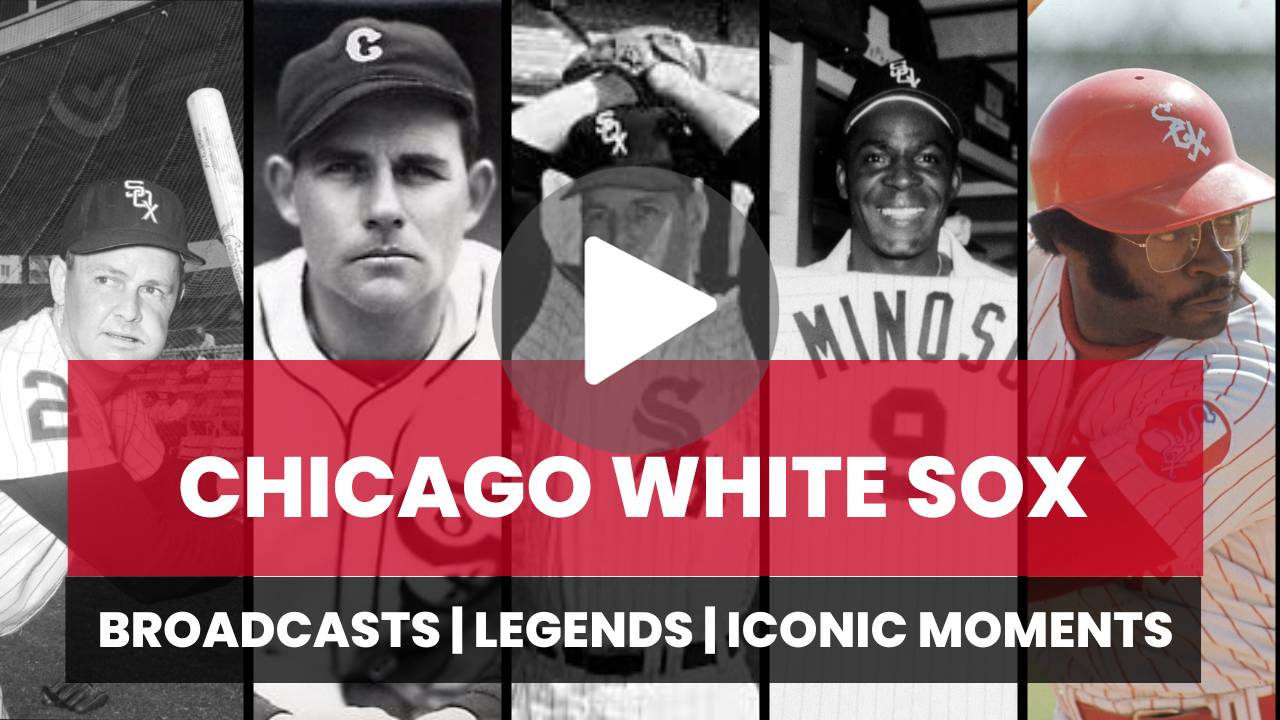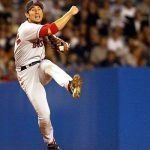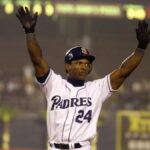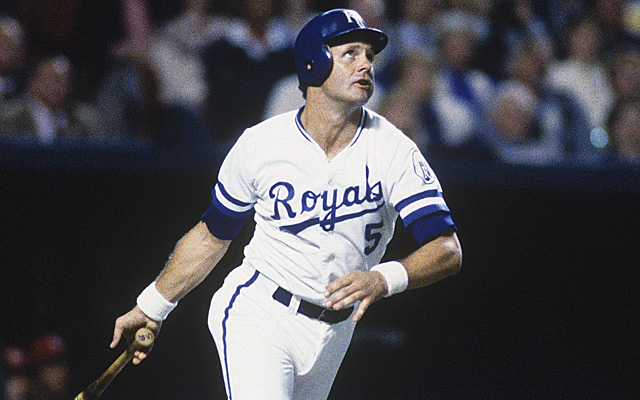Larry Walker Stats & Facts
Larry Walker
Positions: Rightfielder and First Baseman
Bats: Left • Throws: Right
6-2, 185lb (188cm, 83kg)
Born: December 1, 1966 in Maple Ridge, Canada
High School: Maple Ridge HS (Maple Ridge, BC)
Debut: August 16, 1989 (15,674th in major league history)
vs. SFG 1 AB, 1 H, 0 HR, 0 RBI, 0 SB
Last Game: October 2, 2005
vs. CIN 2 AB, 1 H, 0 HR, 0 RBI, 0 SB
Hall of Fame: Inducted as Player in 2020. (Voted by BBWAA on 304/397 ballots)
Rookie Status: Exceeded rookie limits during 1990 season
Agents: Bob Gilhooley, Jim Bronner, Pat Rooney
Full Name: Larry Kenneth Robert Walker
Nicknames: Booger
Twitter: @Cdnmooselips33
Nine Players Who Debuted in 1989
Steve Finley
Todd Zeile
John Olerud
Sammy Sosa
Omar Vizquel
Ken Griffey Jr.
Juan Gonzalez
Albert Belle
Jim Abbott
All-Time Teammate Team
Coming Soon
Notable Events and Chronology
“The Expos’ Larry Walker, who may have the best arm of any rightfielder in baseball, says he threw out five pitchers at first base on one-hop liners to right when he was in the minors. . . On July 4 (1992) he gunned down Padres shortstop Tony Fernandez. . .” – from a Sports Illustrated article, July 27, 1992, about Walker’s first time throwing out a major league position player who was running to first base
“Larry Walker paved the way for guys like me.” – Canadian Jason Bay, after being named Rookie of the Year
Larry Walker is the all time leader in games, at bats, hits, doubles, home runs, rbi, runs, stolen bases, and walks by a player born in Canada. He is the only Canadian to reach the following milestones: 2000 hits, 300 home runs, and 1000 rbi.
Walker retired following the 2005 NLCS.
Early career
Walker, born December 1, 1966, was signed by the Montreal Expos as a free agent in 1984. As a youth he had played both hockey – he was a goalkeeper – and baseball growing up in Maple Ridge, British Columbia, and was a close friend of future automobile racer Greg Moore. He spent 1985 through most of 1989 in the minors in the Expos organization, usually hitting around .280 with considerable power. He was very raw when he first joined the organization and only hit .223 with 2 home runs in 62 games on loan to the unaffiliated Utica Blue Sox of the New York-Penn Leaguein 1985, but he blossomed in 1986 with the Burlington Expos of the Midwest League, hitting .289 with 29 home runs, and adding 4 more dingers (and 16 extra base hits) in in 38 games for the West Palm Beach Expos of the Florida State League. After slugging 25 doubles, 7 triples and 26 homers for the AA Jacksonville Expos in 1987, he missed all of 1988 due to an injury (see below).
He made his major league debut at the age of 22 in August of 1989, hitting .170 with no home runs in 56 at-bats. His first call-up came as the Expos were losing their hold on first place in the NL East after having held it since June; they hoped that two young but very talented outfielders, Walker and Marquis Grissom, would provide the spark to push them back over the top, but it wasn’t to be. Walker’s most memorable performance that first season was in a 22-inning game against the Los Angeles Dodgers – the longest in team history – on August 23: in the 16th inning, he was called out on appeal for leaving third base early after scoring the apparent winning run on a sacrifice fly; in the 18th, he made a spectacular catch of a line drive off the bat of Eddie Murray against the wall in right field to keep the scoreless tie going. In spite of that inauspicious start, he was not sent back to the minors and instead became the regular right fielder for the 1990 Expos, hitting .241 with 19 home runs.
The Expos’ regular right fielder, Hubie Brooks, became a free agent at the end of the 1989 season and signed with the Dodgers, clearing a spot in the line-up for Walker.
Prime of his career with the Expos
Through the early and middle 1990s, Larry Walker continued to look better and better during most years. He finished second in the NL Rookie of the Year Award voting in 1990, losing out to the Braves’ David Justice after tying the Expos’ rookie record held by Andre Dawson with 19 home runs. In 1992 – still prior to expansion – he hit .300 for the first time and exceeded 20 home runs for the first time. In the strike-shortened 1994 season, after expansion, he led the league with 44 doubles and hit .322.
He won his first Gold Glove in 1992 and was also named to his first All-Star team that year. He would go on to win seven Gold Gloves and be named to five All-Star teams. His highest finish in the MVP voting while with the low-visibility Expos was fifth in 1992. His statistics during those years now appear deflated in comparison with the high-octane offensive era that followed, and were further depressed by playing in pitcher-friendly Stade Olympique, but he was already one of the National League’s greatest offensive forces while with the Expos, and the outfield he formed in 1994 with Grissom and Moises Alou can rank among the great ones in history.
Prime of his career with the Rockies
After the 1994 season, Walker became a free agent and signed with the Colorado Rockies. Following in the financial wreckage of the 1994 strike, Expos General Manager Kevin Malone was instructed to cut payroll no matter what, and as result the Expos even declined to offer Walker arbitration, meaning that they received absolutely no compensation when he signed with the Rockies. Although he had been an excellent hitter in Montreal, with the thin air of Denver his statistics began to look much better. He had his first 100-RBI season in 1995, also taking part in postseason play for the first time as the Rockies were the first wild card winners in National league history. In 1997 had his peak OPS+ of 178, good enough to win the MVP award that year. His 49 home runs in 1997 were the most anyone in the National League had hit since Andre Dawson did so for the 1987 Chicago Cubs.
In 1998, he led the National League in batting, and then in 1999 he did one better by leading the league in batting, OBP and also slugging (in spite of that performance he was only 10th in the league in the MVP voting). In 2001, he led the league for a third time in batting, and hit 38 home runs, his second-best total.
With the Cardinals
Although Walker declined a bit in 2003, he started strong in 2004 but was traded to the St. Louis Cardinals in August. He finished with strong averages of .298/.424/.589 in 82 games at the age of 37.
In his only World Series in 2004, Larry slugged .929 in the Cardinals’ losing effort to the Boston Red Sox. Walker batted second in each game, ahead of Albert Pujols. He returned to the Cardinals in 2005 and showed that he could still hit at the age of 38 when he posted a .384 OBP and .502 SLG. Sadly, he retired after the 2005 season, thus missing the Cardinals’ win of the 2006 World Series.
The injuries
As good as he was, Larry Walker would have been even better if he had not struggled with a multitude of injuries. They started even before the majors – Walker missed all of the 1988 season due to an injury suffered while playing winter ball in Hermosillo, Mexico. He needed surgery and a long rehab program for his knee. He spent the year on the Major League team’s disabled list, and as a result there was some question when he had a great season in 1989 whether he was still eligible for the Rookie of the Year Award. The Commissioner’s office ruled that the year spent on the Major League disabled list should not count as roster time, a ruling that still holds and was immediately applied to teammate Moises Alou in 1992.
In 1994 he suffered a shoulder injury in July, which required him to move to first base as it affected his throwing. The move did not slow down Walker’s hitting, but it affected the Expos, as he took the place of promising rookie Cliff Floyd, while being replaced in the outfield by another promising rookie, Rondell White, and by Lou Frazier.
Near the end of the 1997 season, he hurt his elbow, and he may have tried to come back from surgery too quickly in 1998. He started the 1999 season on the disabled list due to a strained rib cage. Much of the 2000 season was spent on the disabled list. In 2003 he had knee and shoulder injuries and had surgery for both of them in the off-season. Then, at the start of the 2004 season he was put on the disabled list with a strained groin.
Even before he came to the Cardinals, he had been on the disabled list a total of eight times. In 2005 with the Cardinals, he was on the disabled list with a neck injury. Partly because of his history of injuries, Walker had 500+ at-bats in a season only twice in his career, although to be fair he often came close.
Miscellany
Hall of Famer Larry Doby played in the Negro Leagues in 1942 under the name “Larry Walker” to protect his amateur status.
Through 2009 there have been more than three dozen major league players with the last name Walker. While six of them have been All-Stars, none of them have yet made the Hall of Fame. The most famous Walkers are Fleet Walker, Welday Walker, Dixie Walker, Mysterious Walker and “Harry the Hat” Walker.
Career analysis
The question of whether Larry Walker will go into the Hall of Fame is an interesting one. Most fans know that gaudy statistics are easy to put up if a player plays in Colorado. Just to give one example, in 1997 in Coors Field the park factor was 123. That’s a huge benefit to any hitter.

However, in taking the air out of the statistics, it is important not to lose sight of authentic accomplishments. Objective observers gave him the 1997 MVP award, and named him to the All Star team five times.They also gave him 7 Gold Gloves. And, perhaps most impressively, his lifetime Adjusted OPS+ in the majors is 140, a number that puts him in a tie at # 75 on the all-time list with Duke Snider, Jesse Burkett, and Babe Herman. He did not in any case become a good hitter in Colorado; he was already outstanding in the much-more difficult conditions of Montreal.
However, like Babe Herman, Walker’s career numbers are relatively low for someone who played under conditions favorable to hitters. Walker did not reach 500 home runs, but only 383. While some players with 370 to 400 home runs have been elected to the Hall of Fame (such as, most recently, Tony Perez), others have not – such as Frank Howard at 382, Norm Cash at 377, and Gil Hodges at 370. As for RBI, his 1311 lifetime total puts him in a tie with Mickey Vernon, who isn’t in the Hall of Fame. He is also below Graig Nettles, Al Oliver, and Ron Santo on the RBI list, all of whom played when fewer runs were being scored.
He has 2160 hits, which is nowhere near the magic number of 3000. Vada Pinson ten years ago didn’t get in with 2757 hits and Oliver never received serious consideration in spite of collecting 2743. Walker’s 1355 runs scored tie him with Tommy Leach, who is not in the Hall of Fame.
On the other hand, his .565 slugging percentage is # 16 on the all-time list (as of 2005), and a great many Hall of Famers did worse. Chuck Klein, who also played in a hitter’s park and whose career numbers were lower than Walker’s, had a lifetime .543 slugging percentage, and he is in the Hall of Fame.
In the final analysis, it will depend on whether the Hall of Fame voters want to honor a player who, once you take the air out of the Coors Field statistics, was a truly great player but for a period that wasn’t long enough to post the magic numbers of 500 home runs, 1500 RBI, or 3000 hits. In that regard, he is similar to his contemporary Edgar Martinez, who happens to be one of the ten most similar players to Walker (based on the similarity scores method).
Walker was inducted into Canadian Baseball Hall of Fame and Museum in 2009. He is a record nine-time winner of the Tip O’Neill Award presented by the Hall of Fame as the top Canadian player.
Walker was also inducted into Canada’s Sports Hall of Fame in 2007 and the B.C. (British Columbia) Sports Hall of Fame in 2009. In his first year of eligibility for the Hall of Fame, in 2011, he received 20.3% of the vote.
After his playing days
Walker coached for Canada in the 2006 World Baseball Classic and the 2010 Pan American Games Qualifying Tournament.
Notable Achievements
- 1990 Topps All-Star Rookie Team
- 5-time NL All-Star (1992, 1997-1999 & 2001)
- NL MVP (1997)
- 7-time NL Gold Glove Winner (1992, 1993, 1997-1999, 2001 & 2002)
- 3-time NL Silver Slugger Award Winner (1992, 1997 & 1999)
- 3-time NL Batting Average Leader (1998, 1999 & 2001)
- 2-time NL On-Base Percentage Leader (1997 & 1999)
- 2-time NL Slugging Percentage Leader (1997 & 1999)
- 2-time NL OPS Leader (1997 & 1999)
- NL Total Bases Leader (1997)
- NL Doubles Leader (1994)
- NL Home Runs Leader (1997)
- 20-Home Run Seasons: 8 (1992, 1993, 1995, 1997-1999, 2001 & 2002)
- 30-Home Run Seasons: 4 (1995, 1997, 1999 & 2001)
- 40-Home Run Seasons: 1 (1997)
- 100 RBI Seasons: 5 (1995, 1997, 1999, 2001 & 2002)
- 100 Runs Scored Seasons: 4 (1997-1999 & 2001)
- 200 Hits Seasons: 1 (1997
Further Reading
- Danny Gallagher: “Walker the best position player ever from Canada” in Remembering the Montreal Expos, Scoop Press, Toronto, ON, 2005, pp. 209-212.
- Jim Shearon: Over the Fence Is Out!: The Larry Walker Story and more of Canada’s Baseball Legends, Malin Head Press, Ottawa, ON, 2009.
Biography
Coming Soon
@ET-DC@eyJkeW5hbWljIjp0cnVlLCJjb250ZW50IjoicG9zdF90YWdzIiwic2V0dGluZ3MiOnsiYmVmb3JlIjoiTGVhcm4gTW9yZSBhYm91dCB0aGUgdGVhbXMsIHBsYXllcnMsIGJhbGwgcGFya3MgYW5kIGV2ZW50cyB0aGF0IGhhcHBlbmVkIG9uIHRoaXMgZGF0ZSBpbiBoaXN0b3J5IC0gLSAtIC0gLSAtIC0gIiwiYWZ0ZXIiOiIiLCJsaW5rX3RvX3Rlcm1fcGFnZSI6Im9uIiwic2VwYXJhdG9yIjoiIHwgIiwiY2F0ZWdvcnlfdHlwZSI6InBvc3RfdGFnIn19@
Factoids, Quotes, Milestones and Odd Facts
Coming soon
Other Resources & Links
View Player Info from the B-R Bullpen
View Player Bio from the SABR BioProject
If you would like to add a link or add information for player pages, please contact us here.






